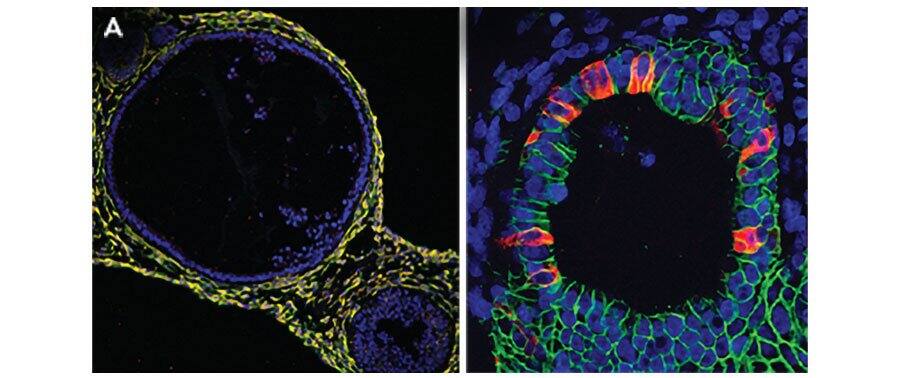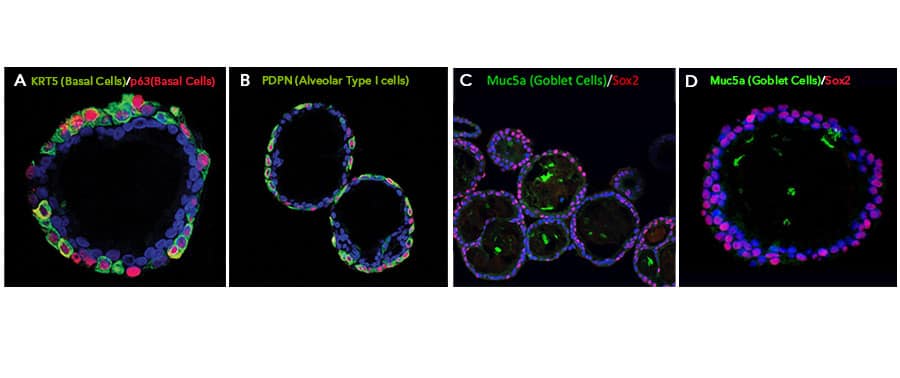|
|
Application of Nicotinamide in Culture and Characterization of iPSC-derived Human Intestinal Organoids.
iPSC-derived human intestinal organoids were cultured using Nicotinamide, Y-27632 dihydrochloride (Catalog # 1254), SB 202190 (p38 MAPK inhibitor) (Catalog # 1264), N-Acetylcysteine (Catalog # 7874), A 83-01 (Catalog # 2939), along with the other reagents listed in the intestinal organoid culture medium recipe in the human intestinal organoid culture protocol. (A) Human intestinal organoids were stained using a Rat Anti-Human/Mouse/Rat Vimentin Monoclonal Antibody (Catalog # MAB2105; green) and a Goat Anti-Human/Mouse Desmin Antigen Affinity-purified Polyclonal Antibody (Catalog # AF3844; red) to visualize myofibroblast cells and counterstained with DAPI (Catalog # 5748; blue). (B) Human intestinal organoids were stained using a Goat Anti-Human/Mouse E-Cadherin Antigen Affinity-purified Polyclonal Antibody (Catalog # AF748; green), a Mouse Anti-Human MUC2 Monoclonal Antibody (Novus Biologicals, Catalog # NBP2-44431; red) and counterstained with DAPI (Catalog # 5748; blue).
|
|
|
Application of Nicotinamide in Culture and Characterization of Adult Stem Cell-derived Lung Organoids.
Adult stem cells isolated from human lung biopsy tissue were embedded in Cultrex UltiMatrix RGF Basement Membrane Extract (Catalog # BME001-05) and cultured for 20-60 days in lung organoid expansion medium, which includes Nicotinamide, Y-27632 dihydrochloride (Catalog # 1254), HEPES (Catalog # 3173), N-Acetylcysteine (Catalog # 7874), A 83-01 (Catalog # 2939), SB 202190 (Catalog # 1264), along with the other reagents used in the human lung organoid culture protocol. Lung organoids were able to differentiate and exhibit markers for various cell types of the lung. Lung organoids were stained with (A) a Rabbit Anti-Human Cytokeratin 5 (KRT5) Monoclonal Antibody (green) and a Goat Anti-Human p63/TP73L Polyclonal Antibody (Catalog # AF1916; red) to visualize basal cells, (B) a Hamster Anti-Mouse Podoplanin (PDPN) Monoclonal Antibody (Novus Biologicals, Catalog # NB600-1015; green) to visualize alveolar type I cells and a Goat Anti-Human p63/TP73L Polyclonal Antibody (Catalog # AF1916; red) to visualize basal cells, and (C, D) a Mouse Anti-MUC5AC Monoclonal Antibody (Novus Biologicals, Catalog # NBP2-15196; green) to visualize Goblet cells and a Mouse Anti-Human/Mouse/Rat SOX2 Monoclonal Antibody (Catalog # MAB2018; red). All samples were counterstained with DAPI (Catalog # 5748; blue).
|
|
|
Application of Nicotinamide in Culture and Characterization of Adult Stem Cell-derived Liver Organoids.
Adult stem cell-derived liver organoids were cultured using Y-27632 dihydrochloride (Catalog # 1254), HEPES (Catalog # 3173), A 83-0 (Catalog # 2939), Forskolin (Catalog # 1099), N-Acetylcysteine (Catalog # 7874), along with the other reagents used in the human liver organoid culture protocol. After 3 days, liver organoid expansion medium was added for 7-10 days, followed by liver organoid differentiation medium, which includes Nicotinamide, HEPES (Catalog # 3173), N-Acetylcysteine (Catalog # 7874), A 83-0 (Catalog # 2939), along with the other reagents used in the human liver organoid culture protocol. Differentiated human liver organoids were stained using a (A) Mouse Anti-Human Serum Albumin Monoclonal Antibody (Catalog # MAB1455; red) and a (B) Goat Anti-Human HNF-3beta Antigen Affinity-purified Polyclonal Antibody (Catalog # AF2400; red) and counterstained with DAPI (Catalog # 5748; blue).
|
|
|
Application of Nicotinamide in Culture and Characterization of Adult Stem Cell-derived Human Descending Colon Organoids.
Adult stem cells isolated from human descending colon were embedded in Cultrex UltiMatrix RGF Basement Membrane Extract (Catalog # BME001-05) and cultured for 30 days in intestinal organoid culture medium, which includes Nicotinamide, Y-27632 dihydrochloride (Catalog # 1254), SB 202190 (Catalog # 1264), N-Acetylcysteine (Catalog # 7874), A 83-01 (Catalog # 2939), along with the other reagents used in the human intestinal organoid culture protocol. (A) Organoids were fixed and stained with a Mouse Anti-Human MUC2 Monoclonal Antibody (Novus Biologicals; Catalog # NBP2-44431; green) to visualize intestinal goblet cells and counterstained with a Goat Anti-Human/Mouse E-Cadherin Antigen Affinity-purified Polyclonal Antibody (Catalog # AF3844; red) and DAPI (Catalog # 5748; blue). The image shown was taken at 10x magnification. (B) Organoids were fixed and stained with a Mouse Anti-Human Chromogranin A Monoclonal Antibody (Catalog # MAB90981; green) to visualize enteroendocrine cells and counterstained with a Goat Anti-Human/Mouse E-Cadherin Antigen Affinity-purified Polyclonal Antibody (Catalog # AF3844; red) and DAPI (Catalog # 5748; blue). The image shown was taken at 20x magnification.
|




